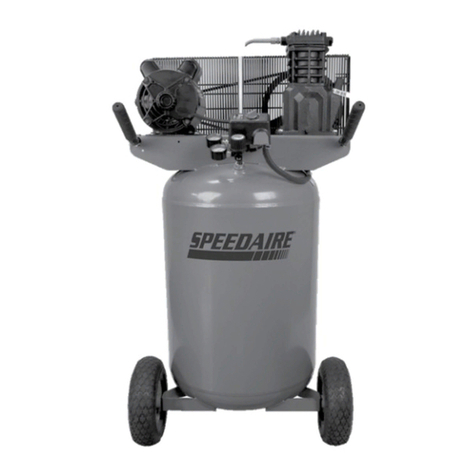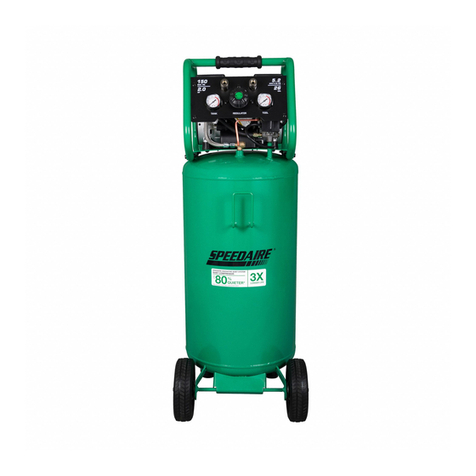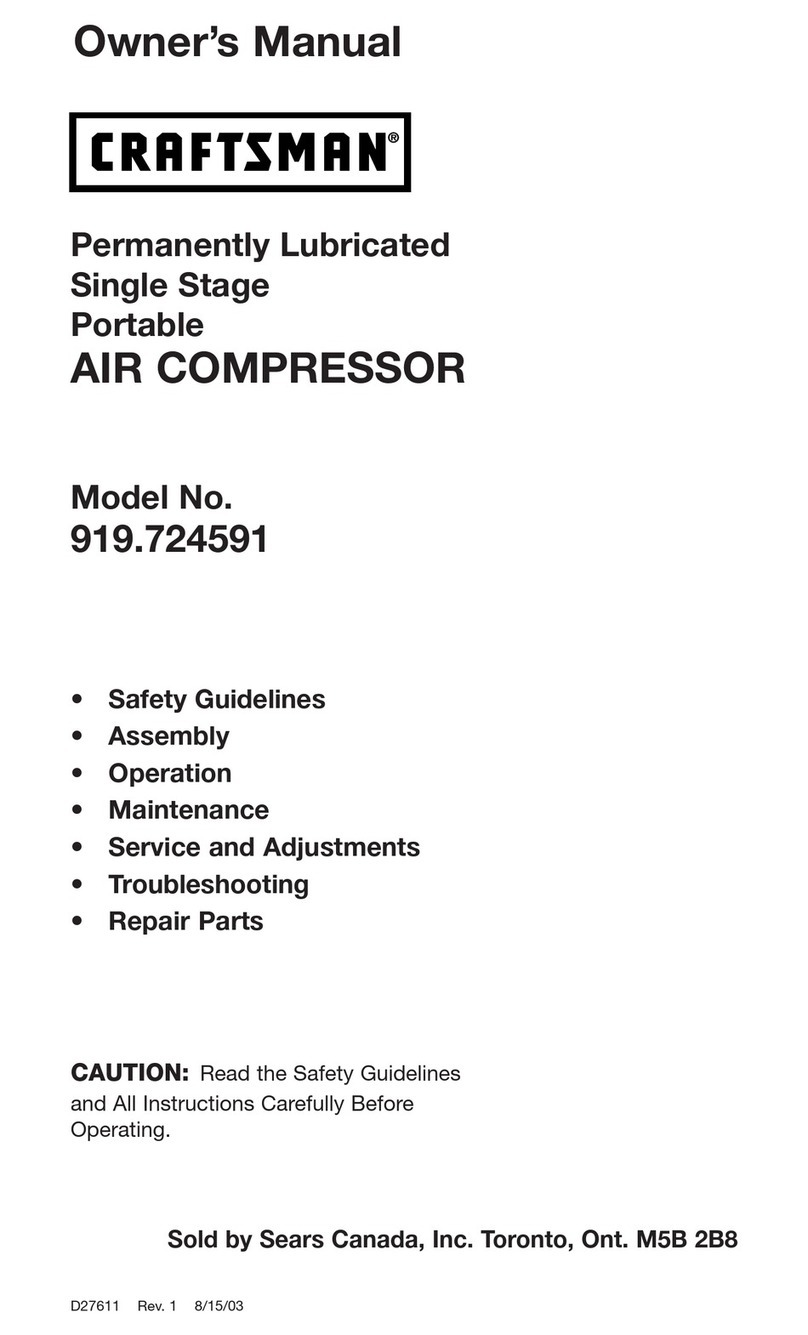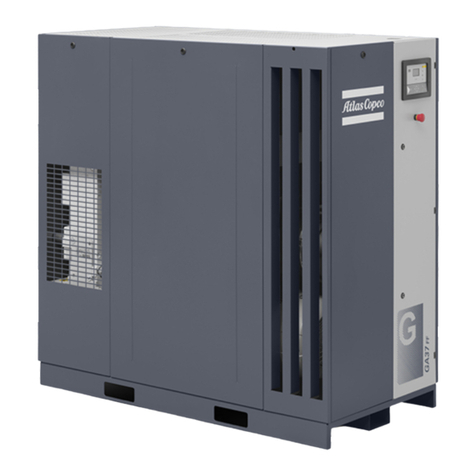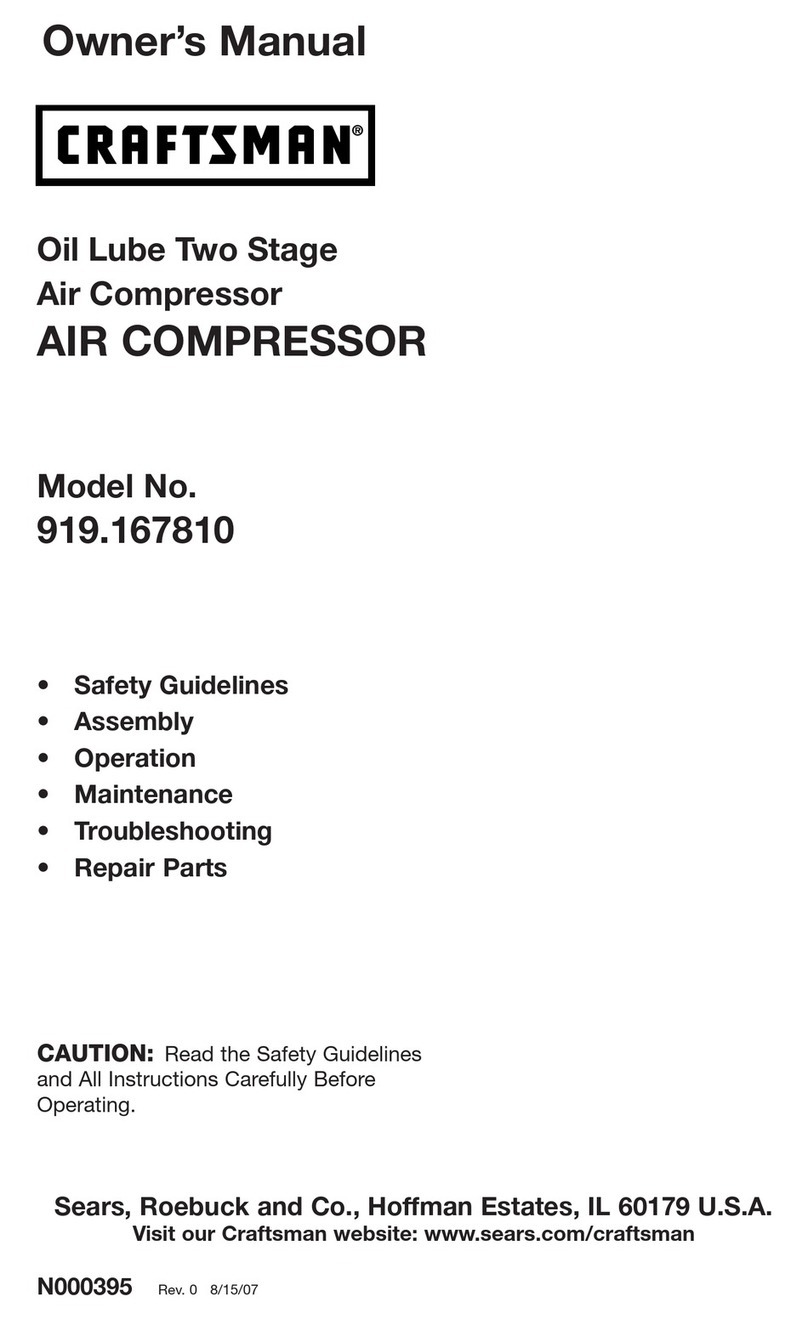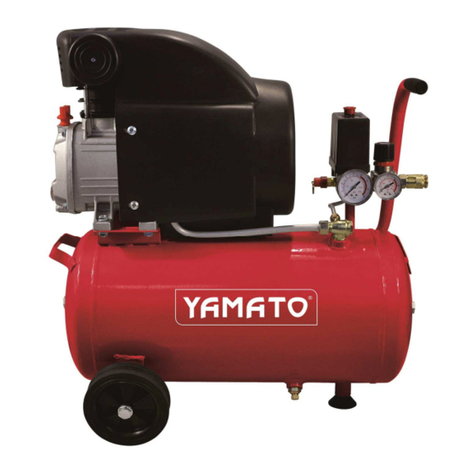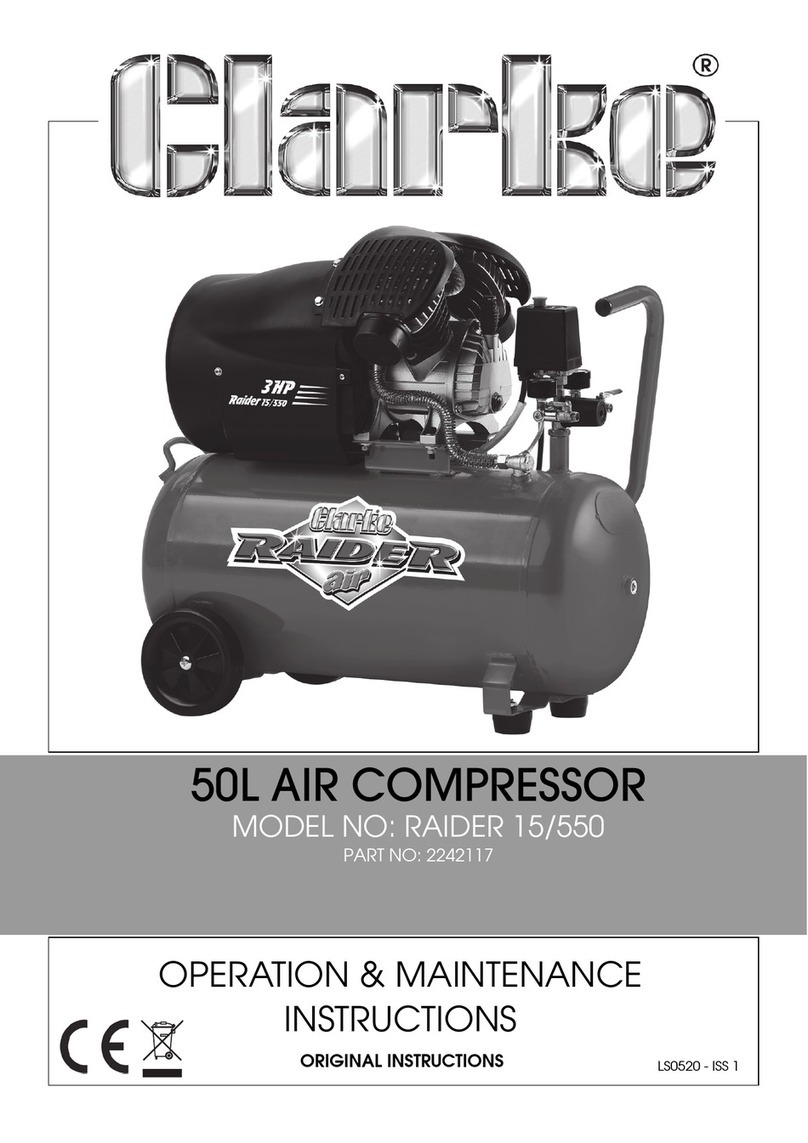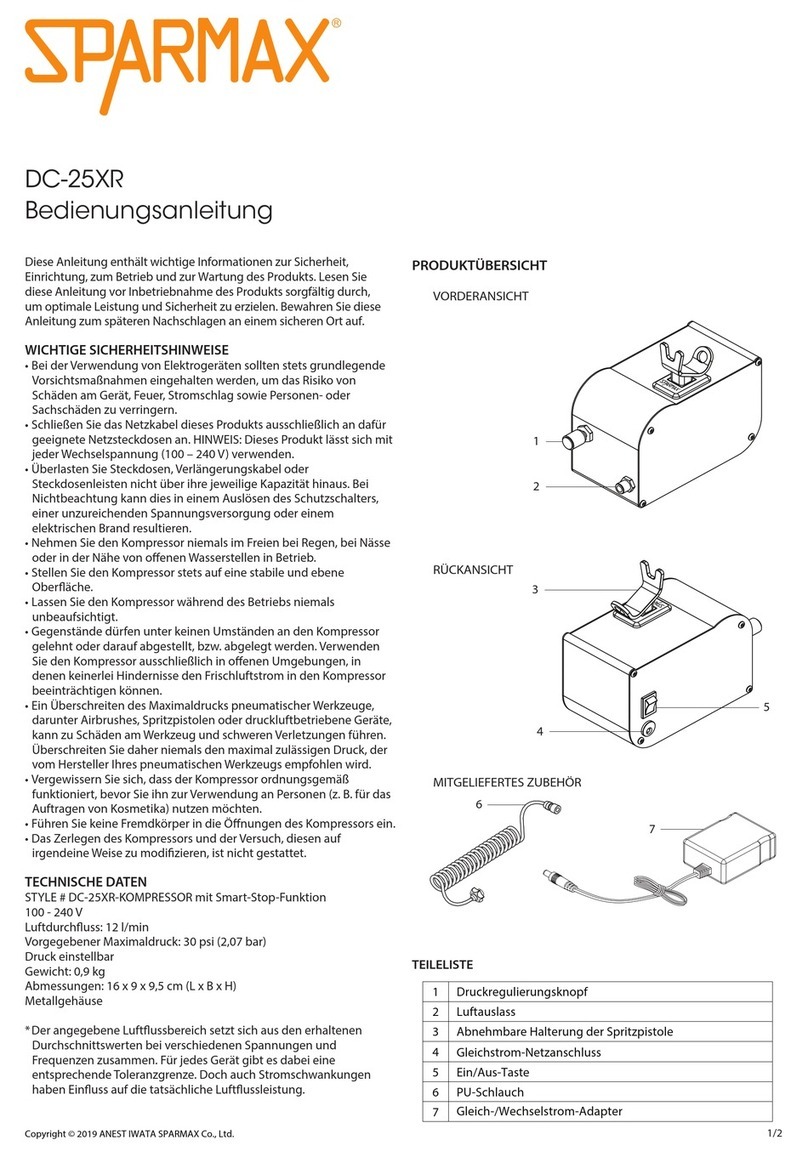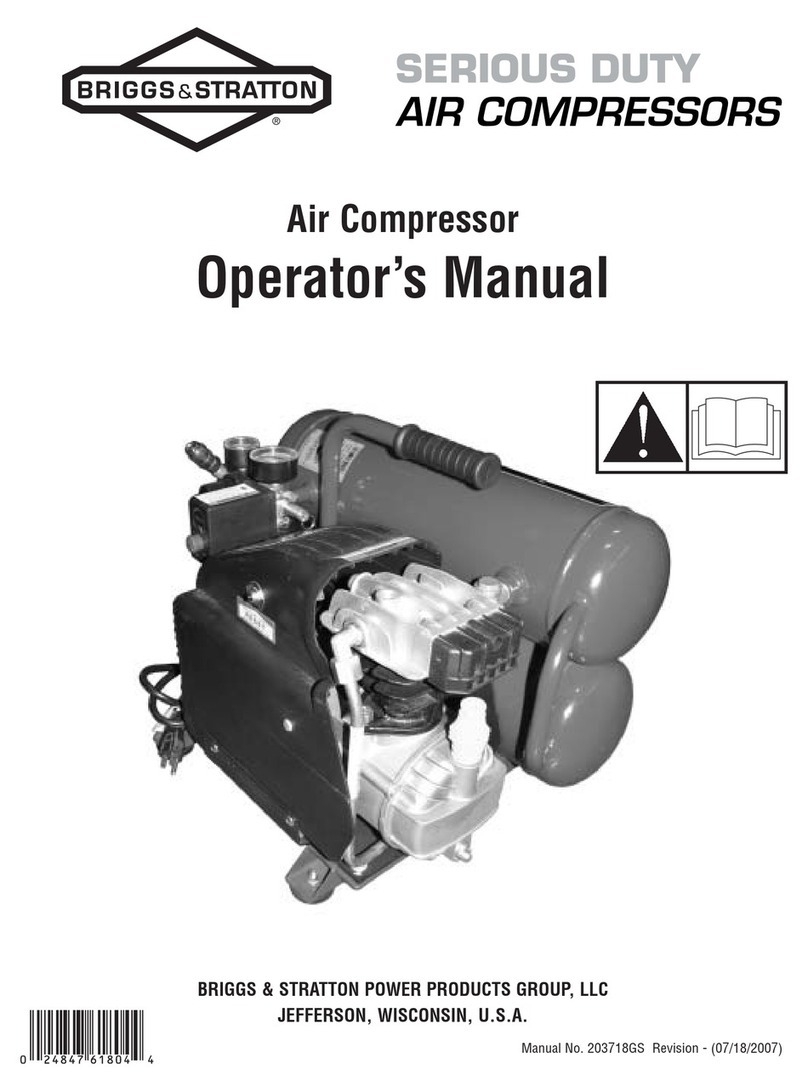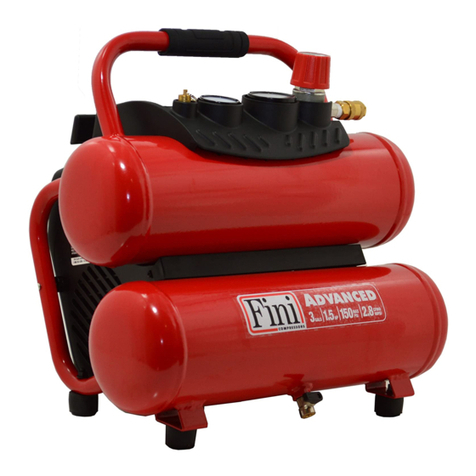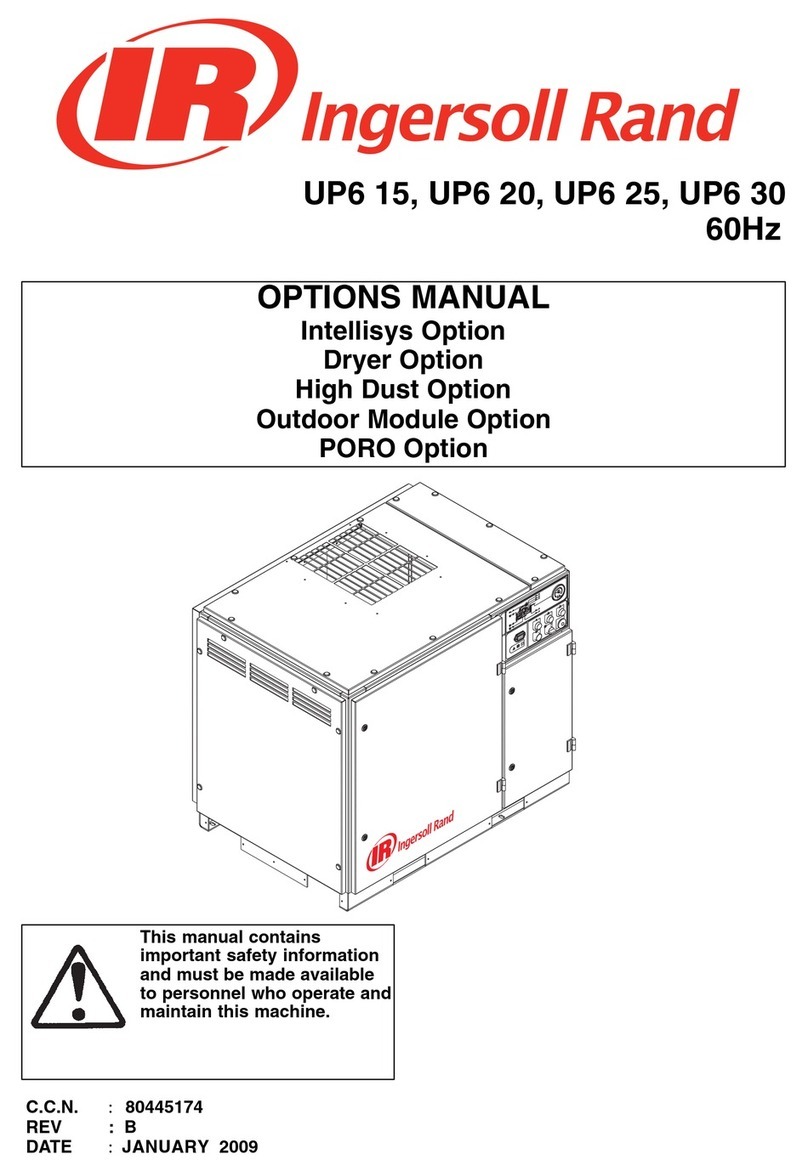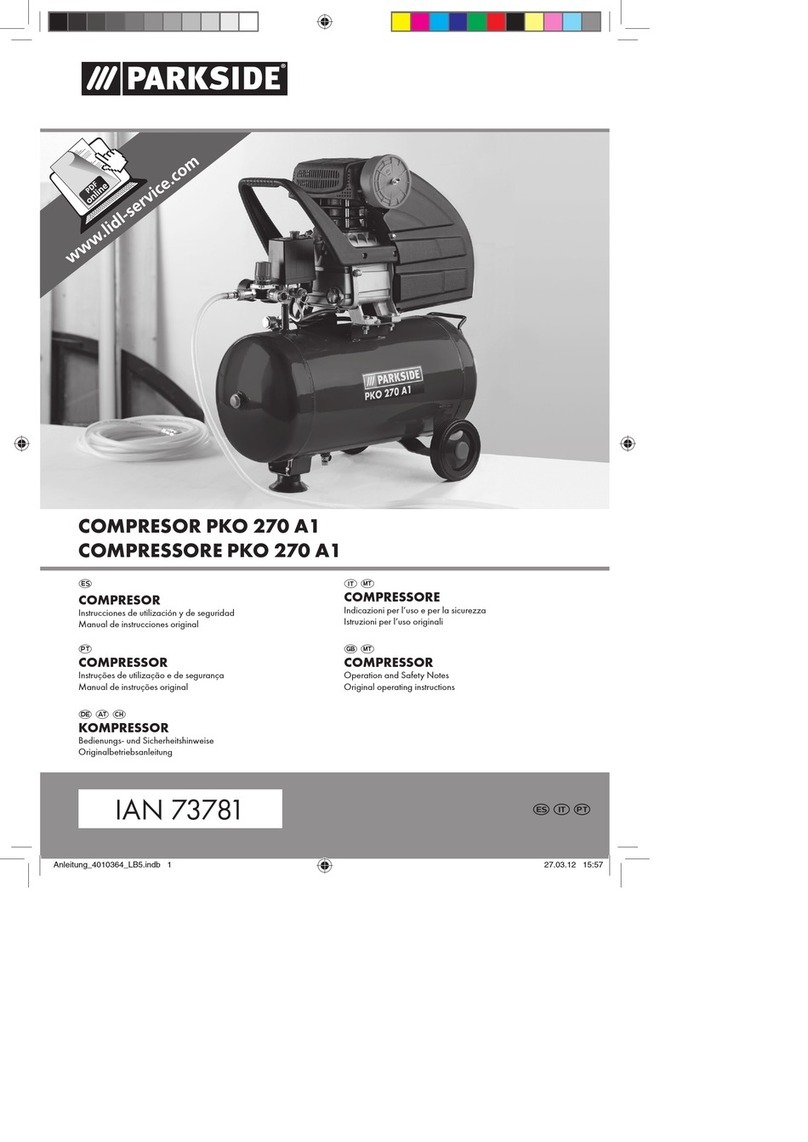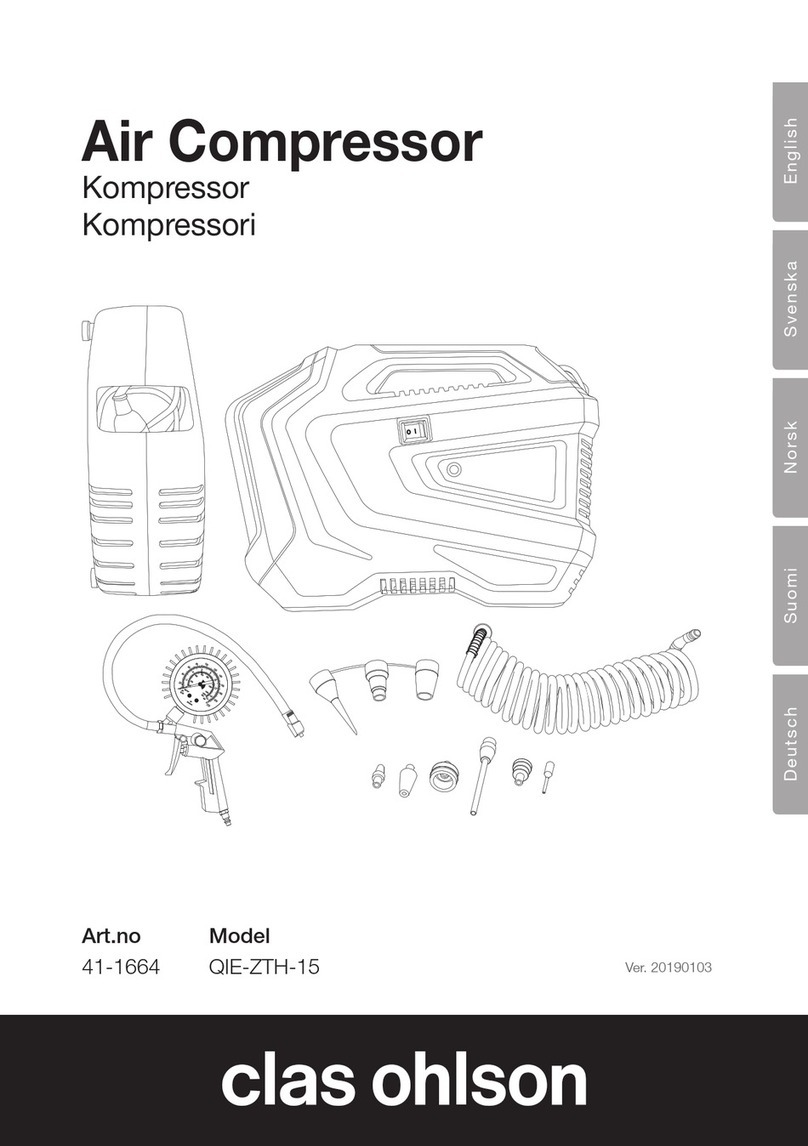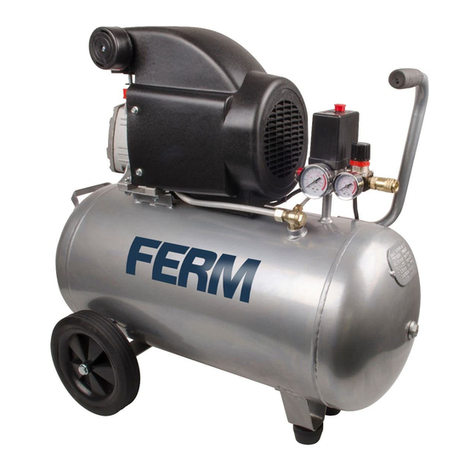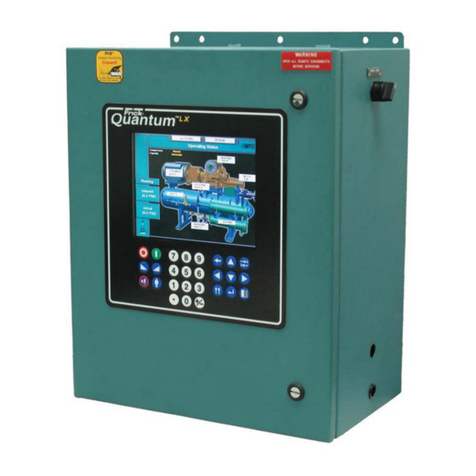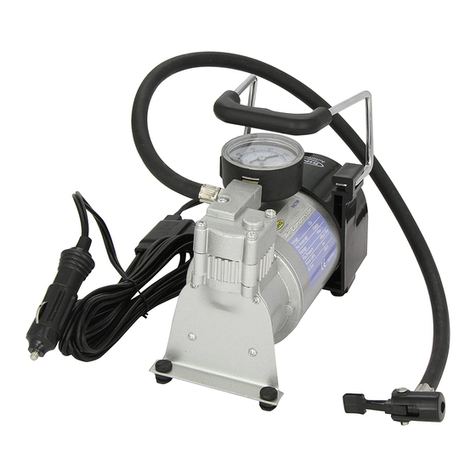Speedaire Cast Iron Series User manual

E
N
G
L
I
S
H
E
S
P
A
Ñ
O
L
F
R
A
N
Ç
A
I
S
Operating Instructions Cast Iron Series
Please read and save these instructions. Read carefully before attempting to assemble, install, operate or maintain the product described.
Protect yourself and others by observing all safety information. Failure to comply with instructions could result in personal injury and/or
property damage! Retain instructions for future reference.
Form 5S6024
Safety Guidelines
This manual contains information that is
very important to know and understand.
This information is provided for SAFETY
and to PREVENT EQUIPMENT PROBLEMS.
To help recognize this information,
observe the following symbols.
Danger indicates an
imminently
hazardous situation which, if not
avoided, WILL result in death or serious
injury.
Warning indicates a
potentially
hazardous situation which, if not
avoided, COULD result in death or
serious injury.
Caution indicates a
potentially
hazardous situation which, if not
avoided, MAY result in minor or
moderate injury.
Notice indicates
important
information, that if not followed, may
cause damage to equipment.
NOTE:Information that requires special
attention.
Breathable Air Warning
This compressor/pump is NOT
equipped and should NOT be
used “as is” to supply breathing
quality air. For any application of
air for human consumption, you
must fit the air compressor/pump
with suitable in-line safety and
alarm equipment. This additional
equipment is necessary to properly
filter and purify the air to meet
minimal specifications for Grade
D breathing as described in
Compressed Gas Association
Commodity Specification G 7.1
- 1966, OSHA 29 CFR 1910. 134,
and/or Canadian Standards
Associations (CSA).
DISCLAIMER OF WARRANTIES
IN THE EVENT THE COMPRESSOR
IS USED FOR THE PURPOSE OF
BREATHING AIR APPLICATION
AND PROPER IN-LINE SAFETY
AND ALARM EQUIPMENT IS
NOT SIMULTANEOUSLY USED,
EXISTING WARRANTIES ARE VOID,
AND DAYTON ELECTRIC MFG.
CO. DISCLAIMS ANY LIABILITY
WHATSOEVER FOR ANY LOSS,
PERSONAL INJURY OR DAMAGE.
Unpacking
After unpacking the unit, inspect
carefully for any damage that may
have occurred during transit. Make sure
to tighten fittings, bolts, etc., before
putting unit into service.
Do not operate tool
if damaged during
shipping, handling or use. Damage
could result in bursting and cause
injury or property damage.
General Safety Information
CALIFORNIA PROPOSITION 65
This product or its
power cord may
contain chemicals known to the State
of California to cause cancer and birth
defects or other reproductive harm.
Wash hands after handling.
You can
create
dust when you cut, sand, drill
or grind materials such as
wood, paint, metal, concrete,
cement, or other masonry. This dust
often contains chemicals known to
cause cancer, birth defects, or other
reproductive harm. Wear protective
gear.
IN613800AV 6/08
Printed in U.S.A.
02433
0608/176/VCPVP
Description
Air compressor units are intended to provide compressed air to power pneumatic
tools and operate spray guns. The pumps supplied are oil lubricated. A small amount
of oil carryover is present in the compressed air stream. Applications requiring air
free of oil or water should have the appropriate filter installed. The air compressor
unit must be mounted on a solid floor or solid ground. Any other use of these units
will void the warranty and the manufacturer will not be responsible for problems or
damages resulting from such misuse.
Speedaire®Stationary
Air Compressors
For Warranty & Service call 1-888-606-5587
Do Not Return To Branch

2
E
N
G
L
I
S
H
Speedaire®Stationary Air
Compressors
Speedaire Operating Instructions
General Safety Information
(Continued)
GENERAL SAFETY
Since the air compressor and other
components (material pump, spray
guns, filters, lubricators, hoses, etc.)
used, make up a high pressure pumping
system, the following safety precautions
must be observed at all times:
1.
Read all manuals included
with this product carefully.
Be thoroughly familiar with
the controls and the proper
use of the equipment.
2. Follow all local electrical and safety
codes as well as the United States
National Electrical Codes (NEC) and
Occupational Safety and Health Act
(OSHA).
3.
Only persons well acquainted with
these rules of safe operation should be
allowed to use the compressor.
4. Keep visitors away and NEVER allow
children in the work area.
5. Wear safety glasses and use
hearing protection when
operating the pump or
unit.
6. Do not stand on or use the pump or
unit as a handhold.
7.
Before each use, inspect compressed
air system and electrical components
for signs of damage, deterioration,
weakness or leakage. Repair or replace
defective items before using.
8. Check all fasteners at frequent
intervals for proper tightness.
Motors,
electrical
equipment and controls can
cause electrical arcs that will
ignite a flammable gas or
vapor. Never operate or repair in or near
a flammable gas or vapor. Never store
flammable liquids or gases in the vicinity
of the compressor.
Never
operate
compressor without a
beltguard. Compressors can
start automatically without
warning. Personal injury or property
damage could occur from contact with
moving parts.
9. Do not wear loose clothing or jewelry
that will get caught in the moving
parts of the unit.
Compressor parts may be hot
even if the unit is stopped.
10. Keep fingers away from a running
compressor; fast moving and hot parts
will cause injury and/or burns.
11. If the equipment should start to
abnormally vibrate, STOP the engine/
motor and check immediately for
the cause. Vibration is generally a
warning of trouble.
12. To reduce fire hazard, keep engine/
motor exterior free of oil, solvent, or
excessive grease.
An ASME code safety
relief valve with a
setting no higher than 150 psi MUST be
installed in the tank for this compressor.
The ASME safety valve must have
sufficient flow and pressure ratings to
protect the pressurized components from
bursting.
See compressor
specification decal
for maximum operating pressure. Do not
operate with pressure switch or pilot
valves set higher than the maximum
operating pressure.
13. Never attempt to adjust safety valve.
Keep safety valve free from paint and
other accumulations.
Never
attempt
to repair or modify a tank!
Welding, drilling or any other
modification will weaken the
tank resulting in damage from rupture
or explosion. Always replace worn or
damaged tanks.
Drain liquid from
tank daily.
14.
Tanks rust from moisture build-up,
which weakens the tank. Make sure
to drain tank regularly and inspect
periodically for unsafe conditions such
as rust formation and corrosion
.
15. Fast moving air will stir up dust and
debris which may be harmful. Release
air slowly when draining moisture or
depressurizing the compressor system.
SPRAYING PRECAUTIONS
Do not
spray
flammable materials in
vicinity of open flame or near
ignition sources including the
compressor unit.
16. Do not smoke when spraying paint,
insecticides, or other flammable
substances.
17. Use a face mask / respirator
when spraying and spray
in a well ventilated area
to prevent health and fire
hazards.
18. Do not direct paint or other sprayed
material at the compressor. Locate
compressor as far away from the
spraying area as possible to minimize
overspray accumulation on the
compressor.
19. When spraying or cleaning with
solvents or toxic chemicals, follow the
instructions provided by the chemical
manufacturer.
MANUAL

3
E
N
G
L
I
S
H
Cast Iron Series
Speedaire Operating Instructions
Introduction
Refer to Figure 1 to locate the following
items.
Pressure Switch - Auto/Off Switch.
On some models there is no manual
switch. The switch is permanently in
the auto mode. In the AUTO position,
the compressor shuts off automatically
when tank pressure reaches the
maximum preset pressure. In the OFF
position, the compressor will not
operate. This switch should be in the
OFF position when connecting or
disconnecting the power cord from the
electrical outlet or when changing air
tools.
For units without a manual switch,
whenever the procedures call for
turning the switch to the OFF position,
use the switch at the disconnect device
instead.
When the pressure switch turns the
motor off you will hear air leaking out
of the pressure switch unloader valve
for a short time. This releases the air
pressure from the discharge tube and
allows the compressor to restart easier.
ASME Safety Valve - This valve
automatically releases air if the tank
pressure exceeds the preset maximum.
Discharge Tube - This tube carries
compressed air from the pump to the
check valve. This tube becomes very hot
during use.
To avoid
the risk of
severe burns, never touch the
discharge tube.
Check Valve - One-way valve
that allows air to enter the tank, but
prevents air in the tank from flowing
back into the compressor pump
Belt Guard - Covers the belt, motor
pulley and flywheel.
Never
operate
compressor without a
beltguard. This unit can
start automatically without
warning. Personal injury or property
damage could occur from contact with
moving parts.
Tank Drain Valve - This valve is located
on the bottom of the tank. Use this
valve to drain moisture from the tank
daily to reduce the risk of corrosion.
Reduce tank pressure below 10 psi,
then drain moisture from tank daily to
avoid tank corrosion. Drain moisture
from tank(s) by opening the drain valve
located underneath the tank.
Assembly
Disconnect, tag and lock out
power source, then release
all pressure from the system
before attempting to install, service,
relocate or perform any maintenance.
OIL DRAIN EXTENSION
Some models include an oil drain
extension and cap (found with the
owner’s manual). Install the oil drain
extension and cap before adding oil
to the pump. To avoid oil leaks, it is
highly recommended to apply PTFE
thread sealant tape or thread sealant to
the threads on each end of the oil drain
extension. Screw the cap onto one end
of the extension. Remove the oil drain
plug from the base of the pump and
install the oil drain extension (See Figure
2).
Figure 1
Tank
Outlet
Pressure
Switch
Tank Drain Valve
Beltguard Check Valve
Discharge
Tube
Safety
Valve
Figure 2 Cap
Oil Sight Glass
Dipstick
Breather Fill Line
Add Oil
Dipstick
Oil Drain Extension
Drain

4
E
N
G
L
I
S
H
Speedaire®Stationary Air
Compressors
Speedaire Operating Instructions
NOTE: If your model is equipped with an
oil sight glass, add oil to the center (See
Figure 2).
Assembly (Continued)
LUBRICATION
THIS UNIT CONTAINS
NO OIL! Follow
lubrication instructions before
operating compressor.
Synthetic oil has proven to
provide superior lubrication and
is recommended for Speedaire air
compressors. Use 10W30 100%
synthetic oil such as Mobil 1 (Stock No.
4F743). Single viscosity, ISO100 (SAE 30)
non-detergent compressor oil such as
Mobil Rarus®(Stock No. 4ZF21), can also
be used. Both are available at your local
Grainger branch.
Do not use
petroleum based
automotive oil which has shown to
increase carbon deposits on the valves,
resulting in more frequent service and
reduced life.
If the compressor is run under humid
conditions for short periods of time, the
humidity will condense in the crankcase
and cause the oil to look creamy. Oil
contaminated by condensed water will
not provide adequate lubrication and
must be changed immediately. Using
contaminated oil will damage bearings,
pistons, cylinders and rings and is not
covered under warranty.
NOTE: To avoid water condensation in
the oil, periodically run the compressor
with tank pressure near 120 psi for
single stage compressors by opening
the drain cock or air valve connected to
the tank or hose.
Run the pump for an hour at a time at
least once a week or more often if the
condensation reoccurs.
ADDITIONAL HARDWARE NEEDED
Purchase necessary regulator, plumbing
and filtration devices to attach to
compressor. Make sure pressure ratings
of added components exceed that of the
compressor.
Installation
LOCATION
It is extremely important to install the
compressor in a clean, well ventilated
area where the surrounding air
temperature will not be more than 100°F.
A minimum clearance of 18 inches
between the compressor flywheel or fan
and a wall is required because objects
could obstruct air flow. Do not locate the
compressor air inlet near steam, paint
spray, sandblast areas or any other source
of contamination.
TANK MOUNTING
The tank should be bolted to a concrete
floor or on a separate concrete
foundation. Vibration isolators should be
used between the tank leg and the floor.
When using isolator pads, do not draw
bolts tight. Allow the pads to absorb
vibrations. A flexible coupling should be
installed between the tank and service
piping. The air compressor should be
mounted on a flat, even surface.
Never use the wood
shipping skids for
mounting the compressor.
INSTALLING A SHUT-OFF VALVE
A shut-off valve should be installed on
the discharge port of the tank to control
the air flow out of the tank. The valve
should be located between the tank and
the piping system.
Never install a shut-
off valve between
the compressor pump and the tank.
Personal injury and/or equipment damage
may occur.
PIPING
Never use
plastic
(PVC) pipe
for compressed air. Serious
injury or death could result.
ELECTICAL INSTALLATION
All wiring
and electrical
connections must be performed by a
qualified electrician. Installations must
be in accordance with local and national
codes.
GROUNDING
This product must be grounded. If the
unit comes with a factory installed cord,
plug the cord into a properly sized,
grounded outlet. For units that do not
have a factory installed cord, install
permanent wiring from the electrical
source to the pressure switch with a
ground conductor connected
to the grounding screw on the
pressure switch. A properly
sized cord with a ground
conductor and plug may also be installed
by the user.
Improperly
grounded motors are shock hazards.
Make sure all the equipment is properly
grounded.
WIRING
Local electrical wiring codes differ from
area to area. Source wiring, plug and
Model
Oil Capacity
(approx.)
4ME96 12 oz.

5
E
N
G
L
I
S
H
Cast Iron Series
Speedaire Operating Instructions
protector must be rated for at least the
amperage and voltage indicated on the
motor nameplate, and meet all electrical
codes for this minimum. Use a slow blow
fuse type T or a circuit breaker.
Installation (Continued)
Overheating, short-
circuiting and fire
damage will result from inadequate
wiring.
When the compressor unit is connected
to the electrical supply by permanent
wiring, an approved disconnect device
must be installed in the circuit.
Do not use the pressure switch as a
disconnect while performing service on
the compressor unit. A circuit break
may be used as a disconnect if it is visible
from the compressor and can be locked
in the open or off position.
If the motor does not have built-in
protection, an overload device must be
installed in the supply circuit. Consult
the approriate codes for acceptable
thermal protection. Some 3 Phase motor
installations will require a magnetic
starter as shown in Figure 3.
NOTE: Terminal configuration may vary.
Check the pressure switch markings on
your unit!
Operation
RECOMMENDED BREAK-IN PERIOD
The compressor should be run
continuously for one hour to allow
proper seating of the piston rings.
1. Open drain cock on the tank and
run the compressor unloaded for 60
minutes.
2. Turn off the compressor and close
drain cock. The compressor is now
ready for use.
START-UP (SEE FIGURE 2)
This compressor
pump must be filled
with oil before startup. See Lubrication
section.
Do not attach air
tools to open end of
the hose until start-up is completed and
the unit checks OK.
1. Remove the dipstick breather and
fill pump to the proper oil level. See
Lubrication section.
2. Turn pressure switch lever or knob to
OFF position and plug in power cord
(See Figure 4). Turn off disconnect
switch if there is no lever or knob on
the pressure switch.
3. Turn pressure switch lever or knob to
AUTO position and run unit for 30
minutes to break in the pump parts
(See Figure 4).
4. After use, turn pressure switch lever
or knob to the Off position.
5. If compressor is not used for a long
time period, bleed air from line
and use drain cock to drain water
from the tank. Then, follow the
maintenance schedule.
NOTE: Electric models are equipped
with a pressure switch that automatically
turns the motor OFF when the tank
pressure reaches a preset level. After
L1 L2
PRESSURE
SWITCH THERMAL
UNITS (3)
L3
T2
FUSED BREAKER
OR DISCONNECT
X2
MOTOR
OVER-
LOAD
COIL
T3T1
L1
L2
240V
GROUND
PRESSURE
SWITCH
LINE
M
MOTOR
Figure 3 - Single and 3 Phase Wiring Diagrams
A
U
T
O
/
O
F
F
Figure 4
Off
Auto
This manual suits for next models
1
Table of contents
Languages:
Other Speedaire Air Compressor manuals
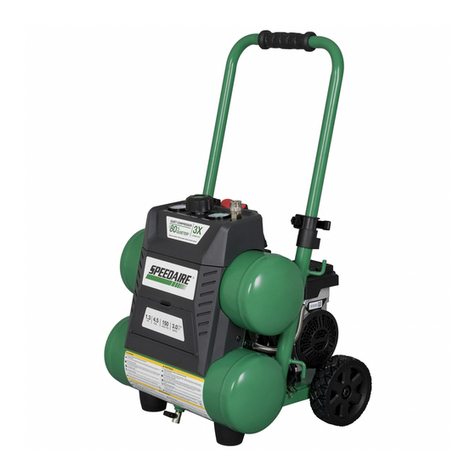
Speedaire
Speedaire 787U78 Instructions for use
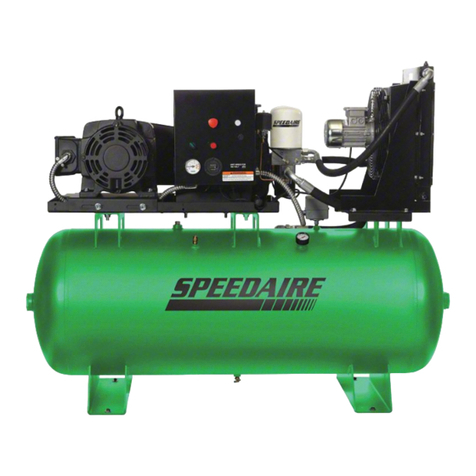
Speedaire
Speedaire 40HU29 User manual
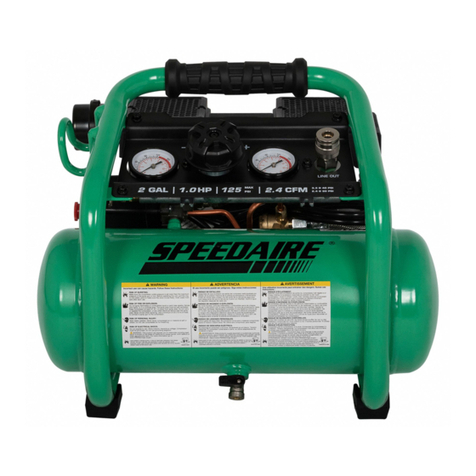
Speedaire
Speedaire 787U77 Instructions for use
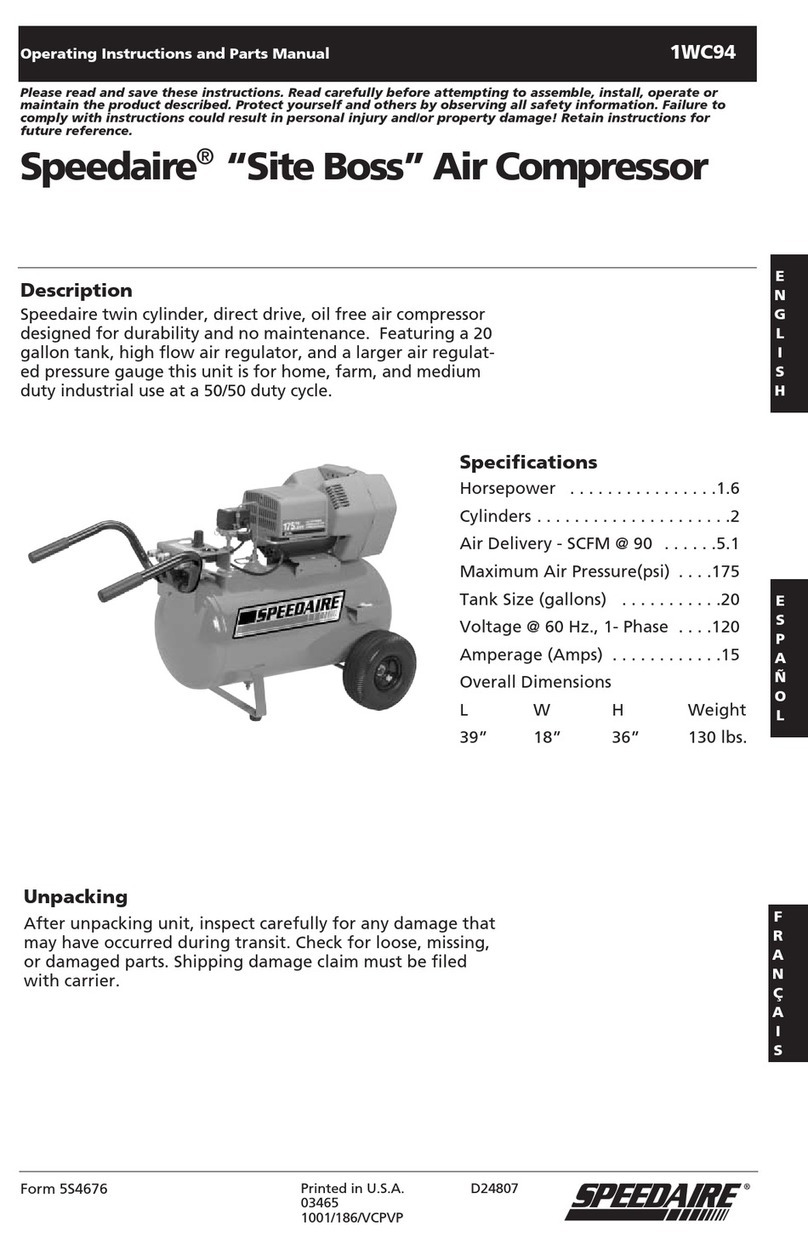
Speedaire
Speedaire 1WC94 User manual

Speedaire
Speedaire 4UP73 Instructions for use
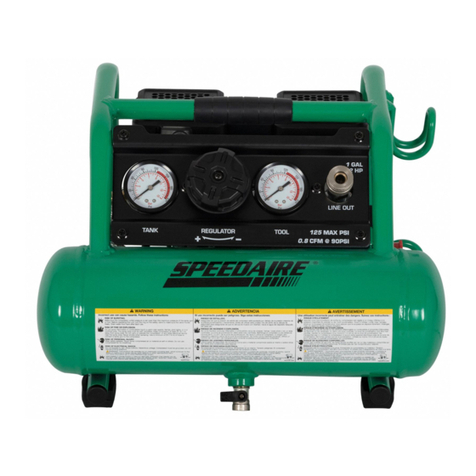
Speedaire
Speedaire 787U76 Instructions for use
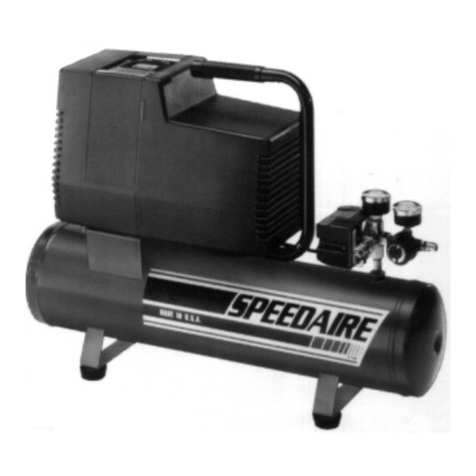
Speedaire
Speedaire 5Z598C Service manual
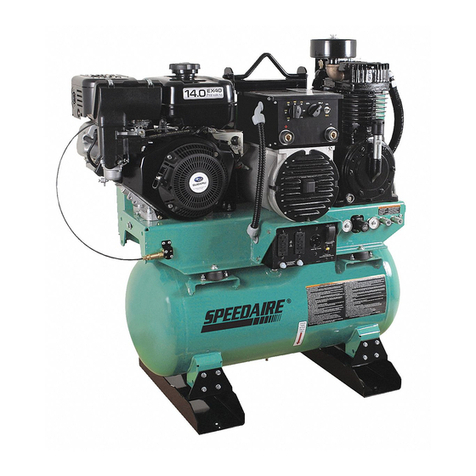
Speedaire
Speedaire 15D802 User manual

Speedaire
Speedaire 1WD36 Instructions for use

Speedaire
Speedaire 1WC95 Service manual
